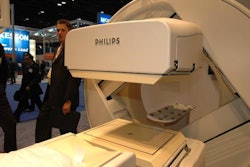CHICAGO - PET has a well-established role for distinguishing benign from malignant lung nodules when CT is inconclusive. Now radiologists have tapped the power of artificial neural networks (ANNs) for a computer-aided detection (CAD) scheme that determines whether PET results can improve the performance of CT-based lung CAD.
At Monday's chest CAD sessions at the 2006 RSNA show, Qiang Li, Ph.D., from the University of Chicago presented the results of his group's effort to develop three artificial neural networks for distinguishing benign from malignant lung nodules using both PET and CT.
"We developed a semiautomated scheme for using artificial neural neural networks for characterizing lung nodules with CT alone, PET alone, and combined PET and CT," Li said.
The study retrospectively examined 92 solitary pulmonary nodules 30 mm and smaller from patients at the University of Chicago hospitals who underwent both CT and FDG-PET for the evaluation of nodules suspicious for lung cancer, Li said. Among the 92 nodules, follow-up or pathology revealed that 42 were malignant and 50 benign.
"The malignant nodules included 17 adenocarcinomas, 12 squamous cell carcinomas, nine small cell lung cancers, two lung metastases, (and) one bronchoalveolar cell carcinoma," he said.
"Sixty-two percent of malignant nodule patients were smokers, while only 24% of benign nodule patients were smokers," Li noted. "Twenty-six percent of smokers had a previous malignancy, while only 10% of nonsmokers had a previous malignancy."
For each case the radiologists extracted 24 features, including four clinical parameters (age, gender, smoking history, and underlying malignancy), 16 CT features (based on size, shape, margin, and internal structure of the nodules), and four FDG features based on standardized uptake values and regional context information.
Three ANNs with one hidden layer were used to distinguish benign from malignant nodules based on all of these features, Li said, including CT alone, PET alone, and the combined modalities. The ANNs were trained and tested with the leave-one-out method, and the output was analyzed with the aid of ROC analysis.
The results showed the superiority of the combined modalities. For distinguishing benign from malignant lesions, the areas under the ROC curve were 0.83, 0.91, and 0.95 for CT, PET, and CT combined with PET, respectively. At a fixed sensitivity of 90%, the specificities were 53%, 72% and 85%, respectively, for the same three ANN combinations.
"There was a statistically significant difference between PET/CT and CT alone (p = 0.015), and also between PET/CT and PET alone (p = 0.037)," Li said.
In a 51-year-old man with a 20-mm nodule that eventually resolved with antibiotics, the ANN scheme could have made a difference in the likelihood of nodule workup. The likelihood of malignancy based on the PET ANN alone was 0.78 (SUV 2.5), indicating a high likelihood of malignancy. However, the PET plus CT ANN yielded a low likelihood of malignancy at 0.41, he said.
When the nodules were grouped by SUV, the results showed that the ANN scheme was especially useful for nodules that have standardized uptake values near 2.5. The results from different size categories showed that the ANN scheme is especially useful for nodules 20 and smaller.
"A CAD scheme based on both CT and PET is superior in characterizing nodules compared to CAD based on PET or CT alone," Li concluded.
A combined PET/CT scanner was used to acquire all images, he said in response to an audience question.
By Eric Barnes
AuntMinnie.com staff writer
November 28, 2006
Related Reading
CT lung cancer screening reduces mortality, October 26, 2006
Barriers still hinder lung CAD adoption, August 24, 2006
Part II: Automated CT lung nodule assessment advances, May 16, 2006
Part I: Automated CT lung nodule assessment advances, April 17, 2006
Copyright © 2006 AuntMinnie.com




















